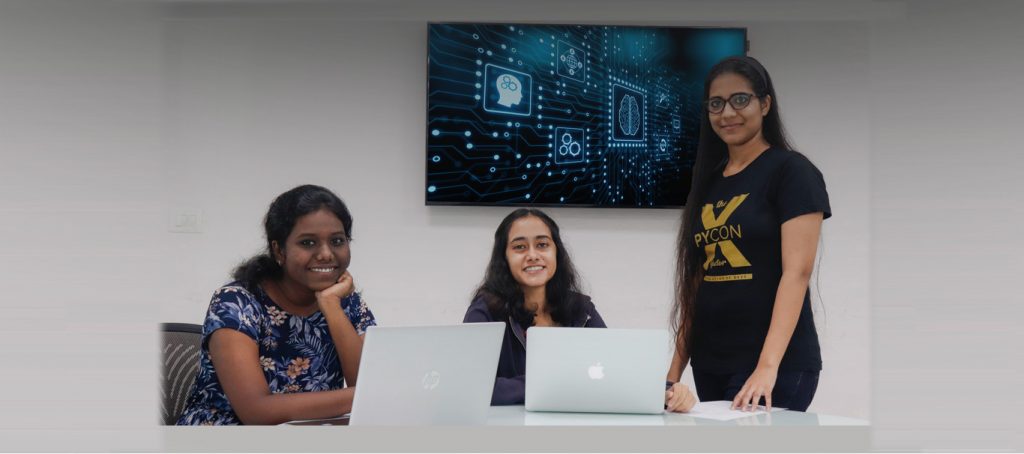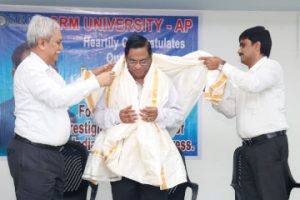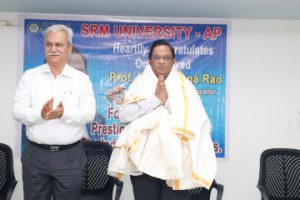NARL lab facilities proposed for collaborative multi-disciplinary research
7th September 2019: Visiting dignitary, Dr. T. Narayana Rao, Sr. Scientist at NARL (National Atmospheric Research Laboratory at Gadanki, Department of Space described the research facilities at the lab and how academia and SRM AP faculty can share these resources to advance their research projects.
According to Dr. Rao, NARL is studying the erroneous GPS signals often caused by atmospheric changes, “NARL scientists are working on studying the atmospheric conditions by deciphering these flawed GPS signals. This is a necessary step as the accuracy of the readings and interpretation is crucial to assess atmospheric pressure, humidity, weather conditions while sending signals to ISRO launch pads.”
With regard to the specific research facilities at NARL, Dr. Rao spoke of the world’s second-largest phased array radar, the sophisticated radio, optical and acoustic instruments. These resources at NARL as well as access to the high-performance computing system of 1.5 Petaflop provides opportunities for academicians, scientists, research scholars and students in different disciplines including physics, chemistry, electronics, computer science and environmental science. Prof. Ranjit Thapa, Department of Physics says, “High-performance computing system deployed by computational researchers can solve critical research problems such as ‘self-healing materials’, ‘catalyst for CO2 and N2 reduction’, and ‘high energy density organic materials’.”
Dr. Rao further spoke of possible faculty participation in combined research studies on the surface and upper atmosphere using advanced MST radar and Lidars. Prof. D. Narayana Rao, Pro-Vice Chancellor highlighted that the central facility of NARL, access to advanced resources and equipment, and opportunity to submit projects in the globally recognized platform validates the importance of carrying out collaborative research with NARL.
- Published in News
WOMEN IN MACHINE LEARNING AND DATA SCIENCE

WiMLDS Amaravati Chapter at SRM AP founders: Sowjanya Naidu Nelli, Abirami Ravishankar and Aakanksha Chouhan
The Amaravati chapter of WiMLDS will work out of the SRM AP campus to provide support and promote women and gender minorities from the entire Amaravati region who are practicing, studying or interested in the field of machine learning and data science. The Amaravati chapter has the added distinction of having the youngest founding members of the worldwide WiMLDS network.
Abirami believes this initiative is important for several reasons, “Empowering women particularly from our region to pursue ML and AI irrespective of their tech/non-tech background, encourages diversity, economic growth, and equality across socio-economic backgrounds.”
WiMLDS has chapters in North America, Africa, Middle East, Europe, South Africa, Asia and Australia. The Amaravati chapter at SRM AP is the newest one in India.
“This organization (chapter) is looking to create opportunities for members to engage in technical and professional conversations in a positive, supportive environment by hosting talks by women and gender minority individuals working in data science or machine learning, as well as hosting technical workshops, networking events and hackathons.” says founder Aakanksha Chouhan.
The fields of Machine Learning and Data Science are growing exponentially both in real life applications and in academia. “Nature has always incentivized the human race when we observe accurate patterns in it,” says Sowjanya, “We used to call it ‘predictions’ till the 1950’s; now it goes by the name of Machine learning and Data Science.”
Aakanksha learned of this WiMLDS at PyCon Italy. “There I met members of WiMLDS from the Poland and Paris chapters. Subsequently, through the mentors at Next Tech lab we got to participate in a live talk session on ‘Women in ML & DS” conducted by Shubhi Sareen of Google Hyderabad who is also a member of WiMLDS Delhi. This led to a conversation with Erin Ledell, founder WiMLDS organization and the Bay Area chapter head and the subject of Amaravati came up and soon this chapter was established.
According to Aakanksha, Machine learning and more appropriately AI is forcing us away from simple and repetitive tasks towards solving real life problems and incubating new ideas. “The shift from ‘if I can’ to ‘how I can’ is exciting! And we can agree that these wonderful communities that exist have contributed immensely to push the human race forward and I’m happy to see that – we’re innovating!”
http://wimlds.org/about-the-amaravati-team/
Twitter : WiMLDS_AMVT
Instagram : wimldsamaravati
Women in Machine Learning and Data Science – 2019 Inauguration WiMLDS – Amaravati Chapter
- Published in News
Pro VC, Prof. D. Narayana Rao awarded with Fellowship of the Indian Science Congress
Prof. D. Narayana Rao receives honoured for his outstanding contributions to Physical Sciences
Prof. D. Narayana Rao, Pro Vice Chancellor, SRM University-AP, Amaravati has been conferred with the Fellowship of the Indian Science Congress (FISC) for his outstanding contributions to Physical Sciences.

The Fellowship has been awarded to Prof. Rao by the Indian Science Congress Association at their Council Meeting held in Bangalore on 16th October 2019. The main objective of ISCA is to advance and promote the cause of Science in India, recognize and support excellence in scientific research, technologies and innovations. Prof. Rao’s outstanding achievements and sustainable significant contributions to sciences were recognised and honoured.

SRM University AP organized a felicitation ceremony for Prof. Rao on this occasion where he encouraged the professors to pursue research by stating its significance. The ceremony was chaired by Dr. D Gunasekaran (Registrar), Dr. B Sivakumar (Deputy Registrar), and Dr. Anil K Suresh (Associate Professor, Biotechnology) who congratulated Prof. Rao on his achievements along with the faculty and staff members of the university.
- Published in News
Bennet Benny (B.Sc. Physics, second year) wins Sakura Internship Program-2019 at Japan Advanced Institute of Science and Technology (JAIST)
Bennet Benny has been honoured with the opportunity to attend an internship under the supervision of Prof. Ryo Maezono at JAIST, Japan. Established in 1990, JAIST is one of the research-intensive institutes for post-graduate studies located in the centre of Ishikawa Science Park (ISP). The internship is funded by the Japan Science and Technology Agency (JST), a government funding agency.
Under the guidance of Prof. Ranjit Thapa, Bennet had applied for the internship in March. This internship begins on 16th December and will continue till 24th December,2019. Bennet will be given hands-on tutorial on electronic structure calculations using DFT and QMC computational methods on one of the supercomputers located at JAIST. He will be joined by five other students from Bandung Institute of Technology, Indonesia.
“I am very excited to be given this opportunity as it will provide me with excellent practical experience and ample exposure that will be helpful to build my career.”, says Bennet and further expresses his gratitude towards Prof. D Narayana Rao, Pro-Vice-Chancellor, SRM University AP, and Dr. Sabyasachi Mukhopadhyay, Assistant Professor, Department of Physics for their immense encouragement and guidance.
- Published in News

